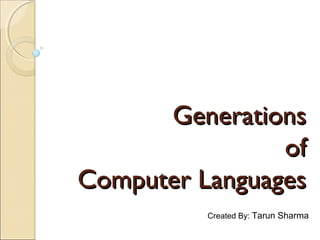Generations of Programming Languages
•Als PPT, PDF herunterladen•
15 gefällt mir•9,574 views
Melden
Teilen
Melden
Teilen

Empfohlen
Empfohlen
Weitere ähnliche Inhalte
Was ist angesagt?
Was ist angesagt? (20)
Ähnlich wie Generations of Programming Languages
Language,
Low-level languages,
High-level languages,
CHARACTERSTICS OF LOW LEVEL LANGUAGES
Third generation languages (3GL)
Types: - C++
VISUAL BASIC
JAVA
JAVASCRIPT
Basic Meaning of Computer languages

Basic Meaning of Computer languagesAmity University | FMS - DU | IMT | Stratford University | KKMI International Institute | AIMA | DTU
Evolution and History of Programming Languages - Software/Hardware/System
Machine languages
Assembly languages
Higher-level languages
Evolution and History of Programming Languages - Software/Hardware/System

Evolution and History of Programming Languages - Software/Hardware/SystemAmity University | FMS - DU | IMT | Stratford University | KKMI International Institute | AIMA | DTU
Ähnlich wie Generations of Programming Languages (20)
Generation of Computer language by arya dutta (1).pptx

Generation of Computer language by arya dutta (1).pptx
Evolution and History of Programming Languages - Software/Hardware/System

Evolution and History of Programming Languages - Software/Hardware/System
Mehr von Tarun Sharma
Mehr von Tarun Sharma (8)
Kürzlich hochgeladen
Mehran University Newsletter is a Quarterly Publication from Public Relations OfficeMehran University Newsletter Vol-X, Issue-I, 2024

Mehran University Newsletter Vol-X, Issue-I, 2024Mehran University of Engineering & Technology, Jamshoro
Kürzlich hochgeladen (20)
HMCS Max Bernays Pre-Deployment Brief (May 2024).pptx

HMCS Max Bernays Pre-Deployment Brief (May 2024).pptx
Fostering Friendships - Enhancing Social Bonds in the Classroom

Fostering Friendships - Enhancing Social Bonds in the Classroom
Vishram Singh - Textbook of Anatomy Upper Limb and Thorax.. Volume 1 (1).pdf

Vishram Singh - Textbook of Anatomy Upper Limb and Thorax.. Volume 1 (1).pdf
ICT role in 21st century education and it's challenges.

ICT role in 21st century education and it's challenges.
Python Notes for mca i year students osmania university.docx

Python Notes for mca i year students osmania university.docx
ICT Role in 21st Century Education & its Challenges.pptx

ICT Role in 21st Century Education & its Challenges.pptx
On National Teacher Day, meet the 2024-25 Kenan Fellows

On National Teacher Day, meet the 2024-25 Kenan Fellows
This PowerPoint helps students to consider the concept of infinity.

This PowerPoint helps students to consider the concept of infinity.
Generations of Programming Languages
- 1. Generations of Computer Languages Created By: Tarun Sharma
- 2. The Evolution of Programming Languages
- 3. The Evolution of Programming Languages To build programs, people use languages that are similar to human language. The results are translated into machine code, which computers understand. Programming languages fall into three broad categories: • Machine languages • Assembly languages • Higher-level languages
- 4. The Evolution of Programming Languages Machine Language(First Generation) ◦ Machine languages (first-generation languages) are the most basic type of computer languages, consisting of strings of numbers the computer's hardware can use.
- 5. The Evolution of Programming Languages Assembly Language(Second Generation) • Assembly languages (second-generation languages) are only somewhat easier to work with than machine languages. • To create programs in assembly language, developers use cryptic English-like phrases to represent strings of numbers. • The code is then translated into object code, using a translator called an assembler.
- 6. The Evolution of Programming Languages Assembly code Assembler Object code
- 7. The Evolution of Programming Languages Higher-Level Languages Higher-level languages are more powerful than assembly language and allow the programmer to work in a more English-like environment. Higher-level programming languages are divided into three "generations," each more powerful than the last: • Third-generation languages • Fourth-generation languages • Fifth-generation languages
- 8. The Evolution of Programming Languages Third Generation Language • Third-generation languages (3GLs) are the first to use true English-like phrasing, making them easier to use than previous languages. • 3GLs are portable, meaning the object code created for one type of system can be translated for use on a different type of system. • The following languages are 3GLs: FORTAN C COBOL C++ BASIC Java Pascal
- 9. The Evolution of Programming Languages Fourth Generation Language • Fourth-generation languages (4GLs) are even easier to use than 3GLs. • 4GLs may use a text-based environment (like a 3GL) or may allow the programmer to work in a visual environment, using graphical tools. • The following languages are 4GLs: Visual Basic (VB) Visual Age
- 10. The Evolution of Programming Languages Fifth Generation Language ◦ A fifth generation programming language is a programming language are designed to make the computer solve the problem of you. ◦ Fifth generation language are used mainly in artificial intelligence research. ◦ Prolog, OPS5 and Mercury are the best known fifth generation languages.
- 11. Thank You..
